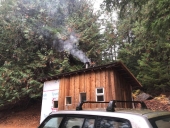








www.thehappypermaculturalist.wordpress.com
 3
3

















God of procrastination https://www.youtube.com/watch?v=q1EoT9sedqY








Bob Carmellio wrote:Would this kind of design work if connected to a 30ft tall standard chimney?









Ron Hansen wrote:Sorry to dig up an old thread, but I have read the whole thing and either no one said or I missed it But.
What is the foot print of the Portable RMS?
And how small can you build an RMS and still expect it to work?
I have an 10' X 12' Green house and want to put one of these in. I am thinking I could fit in a 2'W X 8'L X 2'H.
Would that be too small for a 6" system?
Thanks for this site its great I have learned a ton of stuff!
R Hansen.
 )
)








Ron Hansen wrote:Sorry, I meant the bench part would be 2' high, I was going to try to use one of the small 36 inch tall
barrels like you can get from the quick lube places for my riser and build a standard burn tunnel
under that. I was also thinking I could get some Refractory cement and make the bottom part for the
burn tunnel over some 6 inch corrugated tube to get the shape then fill in the ridges after the tube
was removed from the molded piece to make the chamber smooth for better flow.
Hope that makes sense?
Ron





God of procrastination https://www.youtube.com/watch?v=q1EoT9sedqY




Satamax Antone wrote:Guys, i think i've found a trick. For portable, i gonna make elements with the half barrel system, embeded into concrete, and make two lengh of bench which can atach to each other.
Here's the skp file.
http://donkey32.proboards.com/index.cgi?action=downloadattachment&board=experiment&thread=560&post=5514&key=aibTimMeeDJExHl4iAWe
 ) The volume at the low end could be 50% of the top end volume. This is also why I am putting my mass on top and making the bottom more insulative. If I was using the floor as a mass for heat storage I would not worry about that though.
) The volume at the low end could be 50% of the top end volume. This is also why I am putting my mass on top and making the bottom more insulative. If I was using the floor as a mass for heat storage I would not worry about that though.




God of procrastination https://www.youtube.com/watch?v=q1EoT9sedqY





God of procrastination https://www.youtube.com/watch?v=q1EoT9sedqY




Satamax Antone wrote:Len, thinking about it, with the half round up, there's more surface in contact with the mass, for a longer time, as the flue gasses cool down. 8432cm² of steel on the half round, against 5368cm² for the cut side of a steel barrel.









God of procrastination https://www.youtube.com/watch?v=q1EoT9sedqY













Jennifer Charlton-Dennis wrote:Just wondering if anyone is still on this thread?
God of procrastination https://www.youtube.com/watch?v=q1EoT9sedqY




 1
1








 1
1





|
Eliminate 95% of the weeds in your lawn by mowing 3 inches or higher. Then plant tiny ads:
The new permaculture playing cards kickstarter is now live!
https://www.kickstarter.com/projects/paulwheaton/garden-cards
|







